MARKETING
Will ChatGPT Spell the End of Search Engines?
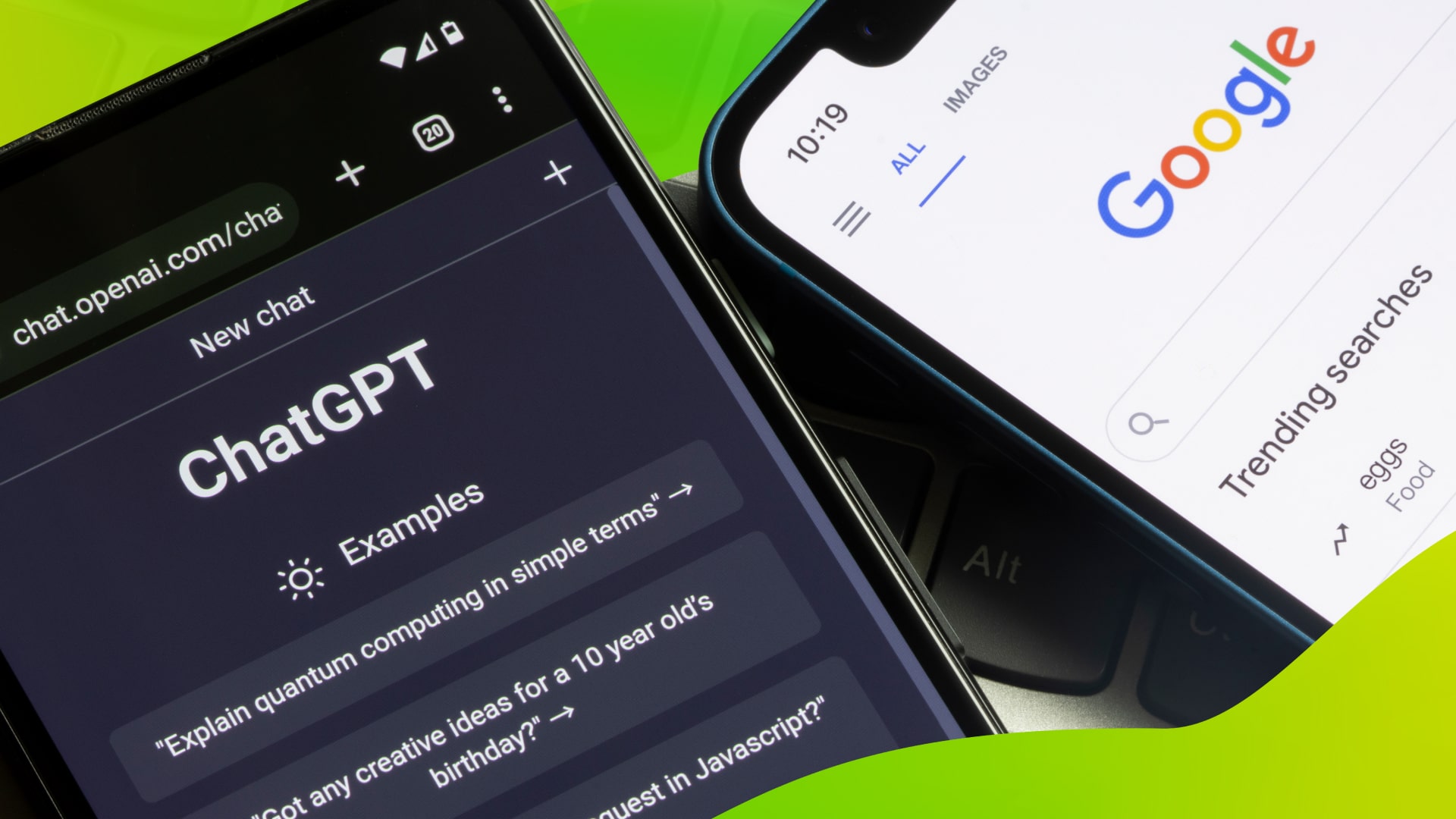
Over the past several months, ChatGPT has been earning enough headline mentions that it’s becoming a bit of a celebrity in its own right. And as for the sentiment of those headlines and supporting articles, many fall into one of two buckets:
- ChatGPT is so exciting—look at all the fun stuff it can do and time it can save!
- ChatGPT is the end of the internet, our jobs, and life as we know it—the time is nigh to prepare for the robot revolution!
At Tinuiti, we’re largely members of the first camp. We recognize that ChatGPT (Chat Generative Pre-trained Transformer) is likely to change how we use the internet—particularly when looking at the functionality and UI of search engines specifically—but where others see a threat, we see a valuable tool.
ChatGPT doesn’t need to be a replacement for anything to be revolutionary; it can be a pivotal cog in the wheels that help improve the search experience for marketers and users alike. In this article, we’ll discuss some of the biggest ways we expect ChatGPT might reshape search (no robot overlords required), and how it can make your life easier.
What is ChatGPT & How Does It Work?
ChatGPT is an AI-powered chatbot developed by OpenAI, an artificial intelligence and research company perhaps best known for their DALL-E and DALL-E 2 deep learning models. ChatGPT was launched in November 2022, and is currently free to use, having earned more than 100 million users by January 2023. For context, it took TikTok nine months to reach that number of users after its successful launch.
Similar to search engines, ChatGPT is designed to help you find the information you’re looking for online. Rather than simply eliciting responses or a list of links to choose from, ChatGPT enables users to engage in a form of conversation.
Users are even able to build on previous questions they have asked in a ChatGPT session, helping them get closer to the results they were looking for, much like refining a search query. These questions can also be driven by the user’s learnings from previous responses, making it easier to explore all those tangents in your mind without opening 100 tabs.
ChatGPT can even deliver an essay-length response given the right prompt, which naturally has many teachers and writers alike concerned. It has even tried its hand at penning a State of the Union speech, in the writing styles of William Shakespeare, Martin Luther King Jr., and other notable historical figures.
As shared by OpenAI:
“The dialogue format makes it possible for ChatGPT to answer followup questions, admit its mistakes, challenge incorrect premises, and reject inappropriate requests. ChatGPT is a sibling model to InstructGPT, which is trained to follow an instruction in a prompt and provide a detailed response.”
In order to deliver the information users are looking for, ChatGPT had to have a lot of training. OpenAI shared that the current model of ChatGPT was trained using Reinforcement Learning from Human Feedback (RLHF), with human AI trainers being instrumental in helping GPT determine whether a provided response was high quality.
To accomplish this, OpenAI had human AI trainers lead both sides of the conversation—a bit like talking to yourself. Trainers were provided with “model-written suggestions to help them compose their responses.” OpenAI then “mixed this new dialogue dataset with the InstructGPT dataset,” transforming that into dialogue format. Comparison data was then collected so they could compare the responses and assess their quality.
ChatGPT Considerations
While ChatGPT does function similarly to a search engine in that it can be used to find answers to queries, it’s important to remember that just like search results themselves, not all of those answers are going to be accurate. To make matters worse, ChatGPT is exceptionally adept at making inaccurate answers sound quite plausible thanks to its language capabilities. If you’re asking it a question about something you know little about, these wrong answers can be tough to spot.
Tools like ChatGPT and Google’s Bard, covered below, are fundamentally “asking” users to add conversation-based behavior to their existing query-based behavior. At least for now, it doesn’t look like they’re planning to have one replace the other.
Additionally, based on how ChatGPT functions today, it is also likely to be more useful for looking for answers than looking for things to purchase.
“For those who are using Google Search for educational or research purposes, I think the potential value-add of an AI-powered chatbot is obvious. But for direct-response or shopping-related behaviors, I think the use cases are a bit more nuanced. I think there are ways to use AI, and LLMs (large language models) particularly, to help make Google Search a more refined product, and to give people better results than what they’re getting today for a lot of searches. But I don’t view ChatGPT as a direct threat to Google’s search business.”
— Josh O’Donnell, Sr. Strategist, Paid Search at Tinuiti
Is ChatGPT a Threat to Google?
If Google didn’t make any changes to adapt to the post-ChatGPT landscape, it could be seen as a threat to how many people would continue to use Google as their primary search engine. But simply put, that isn’t happening.
Google is constantly evolving to meet the changing needs and demands of users and advertisers, with advances in AI and machine learning fueling many of those updates. Among the most foundational ways they evolve is through Google algorithm updates. In addition to the nuanced changes Google is making to their algorithms every day, they also make significant adjustments as necessary to improve user experience and search result quality.
It’s also important to consider that like all new things, the lasting power of the thrill is yet to be seen. Will this simply be a fun new techy thing users experiment with for a few weeks, and quickly forget? Or will this be something that some of us consider a crucial tool in our daily lives, while others simply don’t latch onto the trend at all?
Josh O’Donnell, Sr. Strategist, Paid Search at Tinuiti, notes that ChatGPT may have a similar path of adoption as voice assistants…
“If we think back to when home voice assistants like Amazon Alexa first launched, it suddenly seemed like everyone had one, and many thought that search would be drastically changed as a result. But today—while voice assistants are inarguably very popular—the core search experience has persisted, with added functionality for voice-enabled searches. I think we will see a fairly similar path for AI-powered chat tech. The search experience will evolve to incorporate the new technology, augmenting the search product and powering better search experiences, but the core concept of what a search engine is and what a search engine does will continue to persist.”
How ChatGPT Will Likely Change Google Search
Google is already heavily invested in the AI space, and has a history of adapting to changing needs and technologies. Google recently announced their own conversational AI technology—Bard A.I., powered by LaMDA—noting that it will roll out to “trusted testers” before a public release in coming weeks.
Google announced LaMDA (Language Model for Dialogue Applications) in May 2021, sharing at the time that they had “invented machine learning techniques that help us better grasp the intent of Search queries.” They also shared that “LaMDA’s conversational skills have been years in the making,” and the language model was built on Transformer, the “neural network architecture that Google Research invented and open-sourced in 2017.” Other recent language models built on Transformer are Google’s own BERT, and GPT-3.
This is all to say that the idea of AI isn’t new to Google, and their own research and technology have helped pave the way for ChatGPT. That said, with great power comes equally great responsibility, and Google has not only power but a reputation to protect. When you’re the world’s largest search engine, the bulk of your work comes in maintaining your position, while others in your space can afford to act more quickly in the name of hoping to secure some of your users.
While Microsoft has plans to integrate GPT into Office products and Bing search by March of this year, and is heavily invested in OpenAI, we expect to see any major changes from Google to be carefully experimented with before widespread release.
Below are two ways we expect the widespread adoption of ChatGPT might change the Google experience:
Option 1: AI-Powered Enhancements to SERPs
In this scenario, the Google search experience as we know it today would remain largely unchanged, but would be updated with some minor AI-powered enhancements to better help users cut through the noise and clutter that SERPs sometimes provide.
Option 2: Refining Searches with AI-Powered Chat
In this scenario, Google would adapt to a new AI-powered chat + search experience, which would present a more refined way to search for things. However, it’s yet to be seen whether the preference for a chat-powered search interface is truly something that will stick with consumers beyond the “aha” moment we currently find ourselves in.
For a preview of what Option 2 might look like on Google and Bing, check out You.com.
Source: You.com
The end-user preference between these two options will be largely dictated by the nature of the search query. For example, simple Q&A searches are going to be better suited to the Q&A format that an AI-powered chatbot can provide. However, for most queries, we still believe search engines will be the preferred route for users.
Sample Scenario:
Let’s consider a searcher is looking to buy a new pair of running shoes. Are they more likely to find value in a list of results along with images of different shoes and customer reviews to help them evaluate which shoe is right for them—like they do today—or would they rather have ChatGPT just tell them what shoe to buy without considering any other sources of information?
For these purchase-related searches—the vast majority of searches that fuel Google’s ad revenue—the traditional search design still seems to make the most sense.
The value of search is that you get multiple options and perspectives from a variety of sources all centrally displayed on one page. GPT-3 and other LLMs will help augment this design to make it more relevant and useful, but we don’t see it fully replacing search as a tool, at least not anytime soon.
For more information about Google’s work on similar projects, check out a few additional developments they have announced in recent years, including:
Scaling behavior of PaLM on a subset of 58 BIG-bench tasks
Source: https://ai.googleblog.com/2022/04/pathways-language-model-palm-scaling-to.html
Additional Expert Takeaways on ChatGPT
“Technology is not going to replace all that we do. But here is one thing it is going to reduce the use of — our fingers. So that instead of merely typing, we can increase the use of our brains & our voices, not to mention our creativity & analytical thinking/problem-solving. Today, we can’t imagine a world of work without email or Slack. But email & Slack didn’t replace humans talking to each other. They just made it faster & more efficient than picking up the phone or faxing. Same for ChatGPT and all the others that will come in its wake.”
— Zach Morrison, CEO of Tinuiti
“I like to think of innovations in AI similar to what we experienced with graphic design. Before Photoshop, digital images were expensive, and not something you could do in-house—and forget about editing or enhancing photos yourself. Photoshop brought all the power to your desktop. We went from thinking Photoshopped images were unbelievable to being weary and in disbelief (that’s Photoshopped!). Today, thanks to Apple and Google, and their AI solutions, our camera phone photos are unbelievable (that came from a phone?!). Then there are those that take those filters and enhancements too far (looking at you, r/instagramreality).
So now we have tools like DALL E and ChatGPT in our hands; if we do this right, we’ll get some unbelievable results, enhancing human creativity and capability. Abuse it? Well, we’ve been here before. We won’t believe what we’re seeing, hearing, or reading.”
— Nirish Parsad, Practice Lead, Emerging Tech at Tinuiti
“Once I have the idea, the slowest part of my working process is starting. It is much easier for me to provide feedback than to start. ChatGPT has been great at starting for me, which allows me to [heavily] edit, finesse, and finish, accelerating the whole process. With the extra time comes more ideas.”
— Jesse Math, VP, Integrated Solutions at Tinuiti
Closing Thoughts
GPT-related tech will undoubtedly disrupt the industry, but it’s hardly the first disruption, and it’s unlikely to threaten Google’s existence, power, and purpose. And—in the right hands, given the right prompts—it can function as an important time-saving tool for searchers and marketers.
Bear in mind that we don’t miss the irony of writing about something that many writers feel will render their jobs obsolete; if that’s the case, it’s a bit like training the person who will replace you. But that’s where it’s important to consider that ChatGPT is drawing its answers and conclusions not from things it has written, but human-provided and uploaded information. It is “intelligently” analyzing that information to determine the best answer to provide, but the information itself did not originate outside the human mind.
Additionally, while ChatGPT has an abundance of information to work with in generating a response, that response will always be based on things that have already been written. If we over-relied on AI-generated content for gathering and generating information, the internet would start to look like a slightly nuanced piece of rehashed duplicate content. Google already knows we don’t want that.
It’s also worth considering that those full-bodied answers ChatGPT often generates when answering a question are exactly the kind of content that professional writers strive to create.
When Google has determined that a resource is a relevant answer for a given query, that landing page is typically rewarded with a higher ranking for related searches in the organic SERPs. In that sense, ChatGPT—which would be drawing its information from what it deemed to be the most credible sources on the internet—can be thought of more as an efficient aggregator. And that is one of the many ways our teams are using it at Tinuiti—as a thought-starter that gets some initial ideas down and flowing.
So in what specific ways can marketers make the best use of this tool to improve their efficiency, and free up more time for strategy and execution? Check back soon for an upcoming blog post providing actionable tips for how PPC marketers can start using the GPT tech that’s available today to make their day-to-day activities easier, or contact us today to chat with a (human!) expert.
MARKETING
How to create editorial guidelines that are useful + template
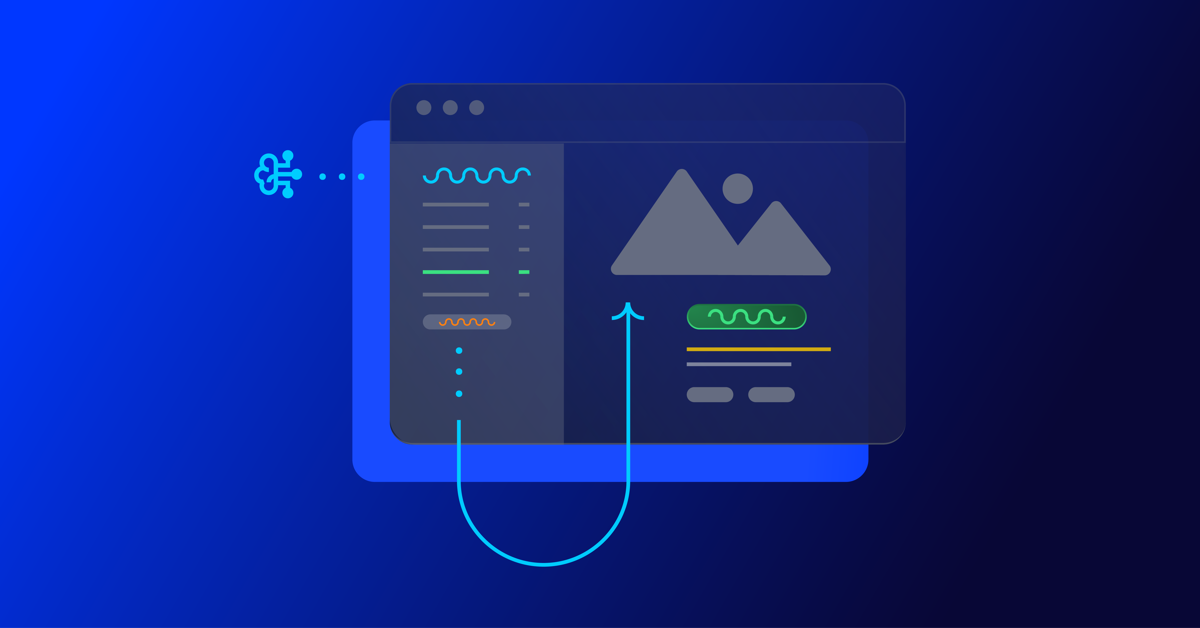
Before diving in to all things editorial guidelines, a quick introduction. I head up the content team here at Optimizely. I’m responsible for developing our content strategy and ensuring this aligns to our key business goals.
Here I’ll take you through the process we used to create new editorial guidelines; things that worked well and tackle some of the challenges that come with any good multi – stakeholder project, share some examples and leave you with a template you can use to set your own content standards.
What are editorial guidelines?
Editorial guidelines are a set of standards for any/all content contributors, etc. etc. This most often includes guidance on brand, tone of voice, grammar and style, your core content principles and the types of content you want to produce.
Editorial guidelines are a core component of any good content strategy and can help marketers achieve the following in their content creation process:
- Consistency: All content produced, regardless of who is creating it, maintains a consistent tone of voice and style, helping strengthen brand image and making it easier for your audience to recognize your company’s content
- Quality Control: Serves as a ‘North Star’ for content quality, drawing a line in the sand to communicate the standard of content we want to produce
- Boosts SEO efforts: Ensures content creation aligns with SEO efforts, improving company visibility and increasing traffic
- Efficiency: With clear guidelines in place, content creators – external and internal – can work more efficiently as they have a clear understanding of what is expected of them
Examples of editorial guidelines
There are some great examples of editorial guidelines out there to help you get started.
Here are a few I used:
1. Editorial Values and Standards, the BBC
Ah, the Beeb. This really helped me channel my inner journalist and learn from the folks that built the foundation for free quality journalism.
How to create editorial guidelines, Pepperland Marketing
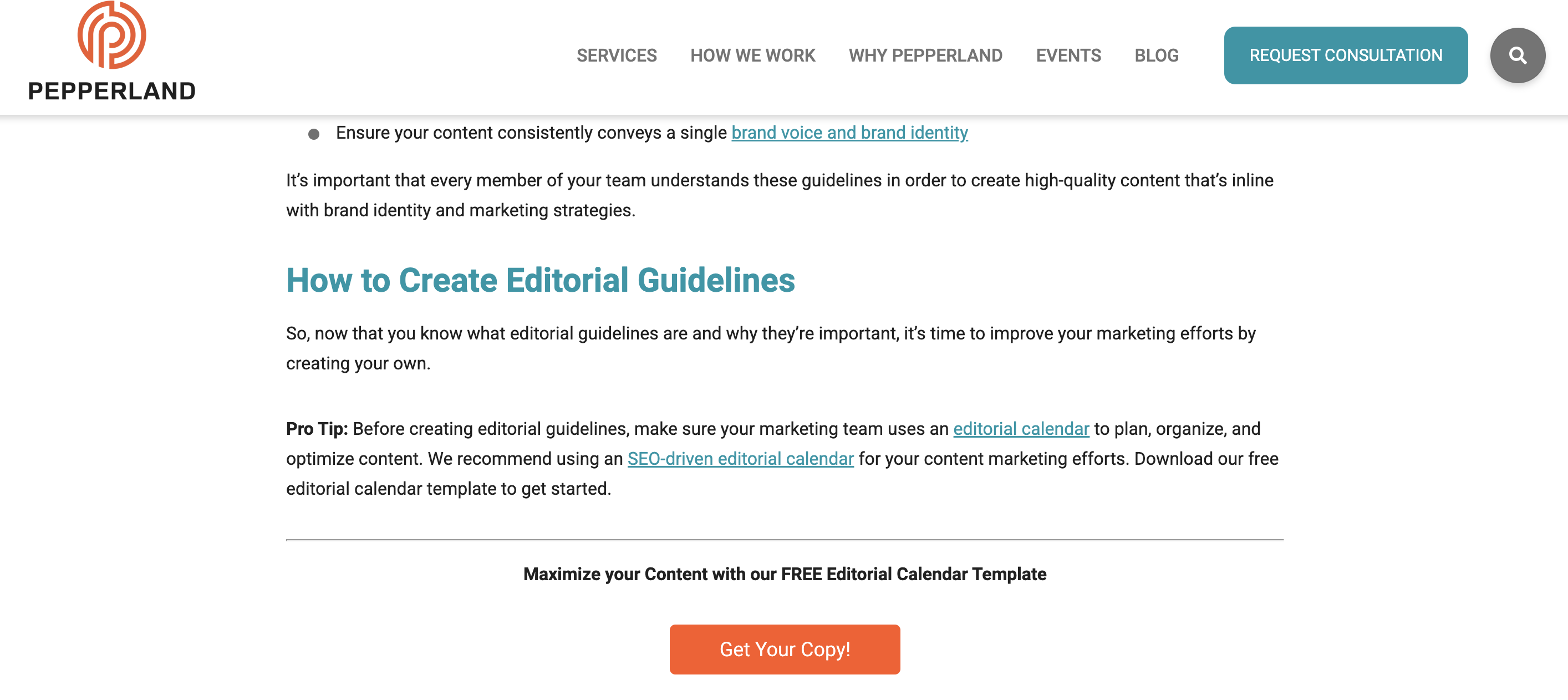
After taking a more big picture view I recognized needed more focused guidance on the step by step of creating editorial guidelines.
I really liked the content the good folks at Pepperland Marketing have created, including a free template – thanks guys! – and in part what inspired me to create our own free template as a way of sharing learnings and helping others quickstart the process of creating their own guidelines.
3. Writing guidelines for the role of AI in your newsroom?… Nieman Lab
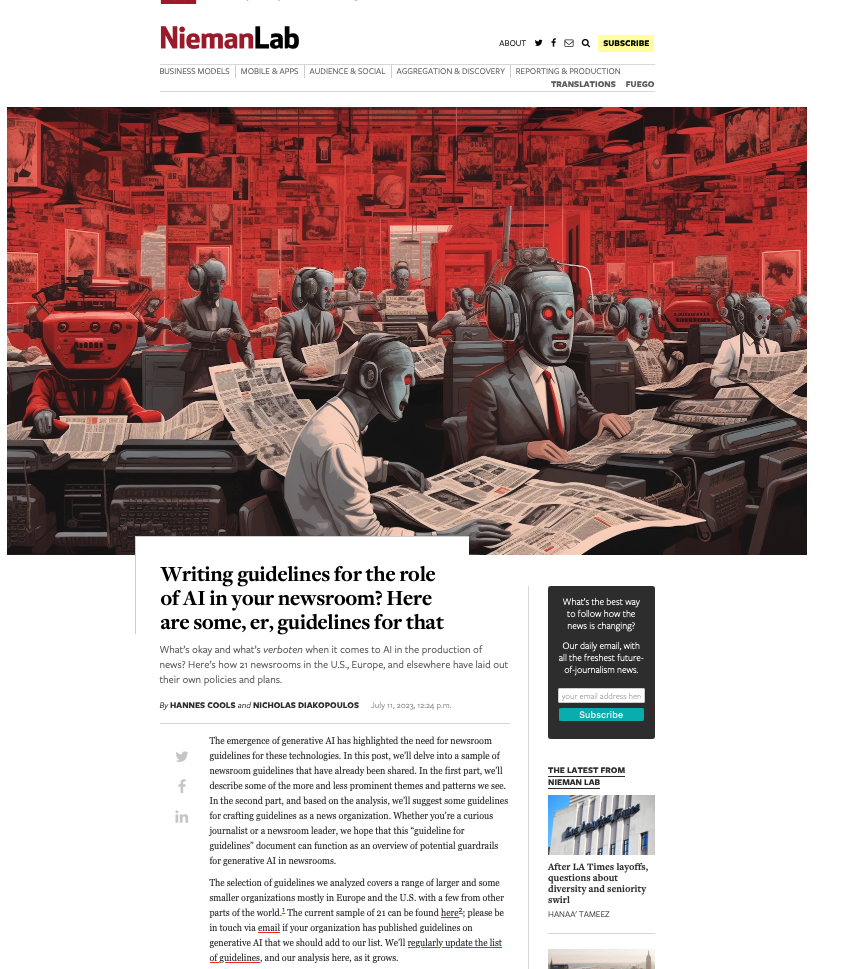
As well as provide guidance on content quality and the content creation process, I wanted to tackle the thorny topic of AI in our editorial guidelines. Specifically, to give content creators a steer on ‘fair’ use of AI when creating content, to ensure creators get to benefit from the amazing power of these tools, but also that content is not created 100% by AI and help them understand why we feel that contravenes our core content principles of content quality.
So, to learn more I devoured this fascinating article, sourcing guidance from major media outlets around the world. I know things change very quickly when it comes to AI, but I highly encourage reading this and taking inspiration from how these media outlets are tackling this topic.
Learn more: The Marketer’s Guide to AI-generated content
Why did we decide to create editorial guidelines?
1. Aligning content creators to a clear vision and process
Optimizely as a business has undergone a huge transformation over the last 3 years, going through rapid acquisition and all the joys and frustrations that can bring. As a content team, we quickly recognized the need to create a set of clear and engaging guidelines that helps content creators understand how and where they can contribute, and gave a clear process to follow when submitting a content idea for consideration.
2. Reinvigorated approach to brand and content
As a brand Optimizely is also going through a brand evolution – moving from a more formal, considered tone of voice to one that’s much more approachable, down to earth and not afraid to use humor, different in content and execution.
See, our latest CMS campaign creative:
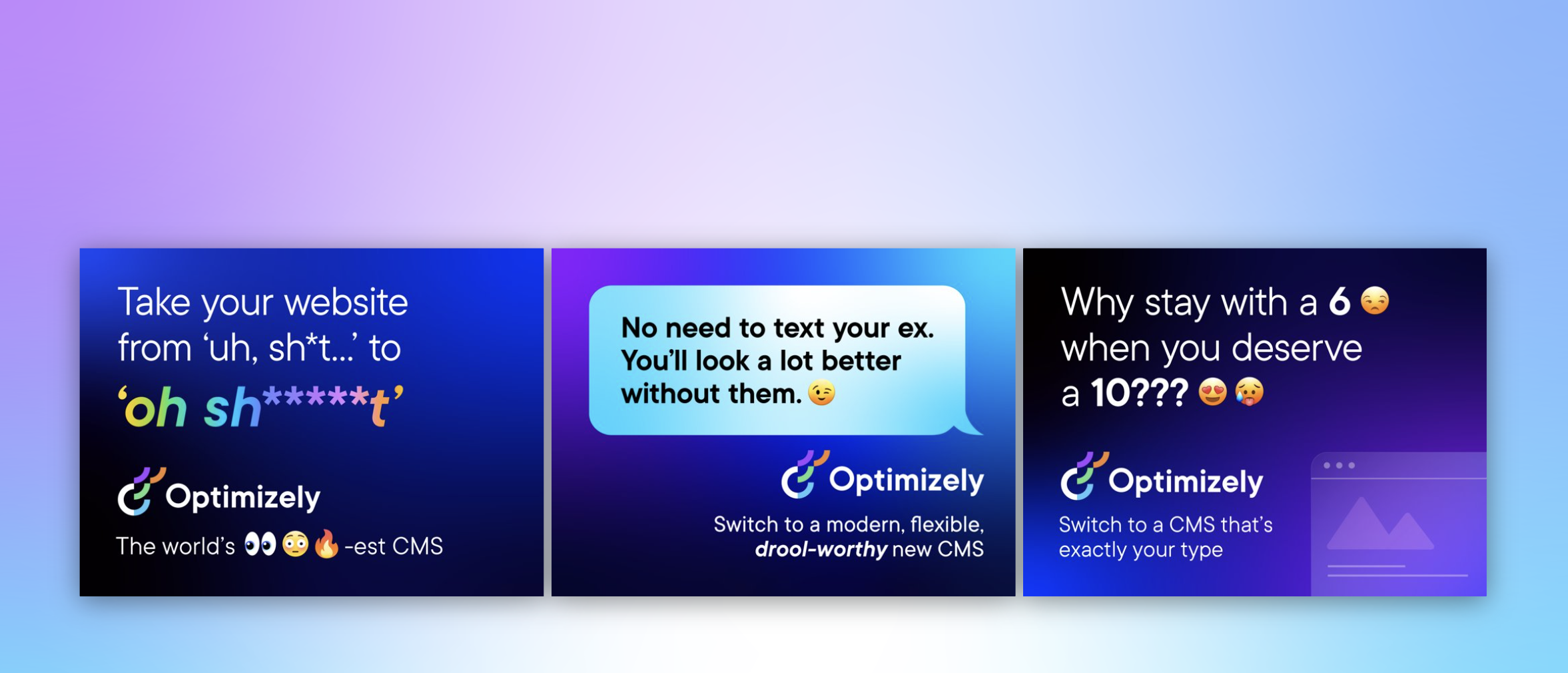
It’s pretty out there in terms of creative and messaging. It’s an ad campaign that’s designed to capture attention yes, but also – to demonstrate our abilities as a marketing team to create this type of campaign that is normally reserved for other more quote unquote creative industries.
We wanted to give guidance to fellow content creators outside the team on how they can also create content that embraces this evolved tone of voice, while at the same time ensuring content adheres to our brand guidelines.
3. Streamline content creation process
Like many global enterprises we have many different content creators, working across different time zones and locations. Documenting a set of guidelines and making them easily available helps content creators quickly understand our content goals, the types of content we want to create and why. It would free up content team time spent with individual contributors reviewing and editing submissions, and would ensure creation and optimization aligns to broader content & business goals.
It was also clear that we needed to document a process for submitting content ideas, so we made sure to include this in the guidelines themselves to make it easy and accessible for all contributors.
4. 2023 retrospective priority
As a content team we regularly review our content strategy and processes to ensure we’re operating as efficiently as possible.
In our last retrospective. I asked my team ‘what was the one thing I could do as a manager to help them be more impactful in their role?’
Editorial guidelines was the number 1 item on their list.
So off we went…
What we did
- Defined a discrete scope of work for the first version of the editorial guidelines, focusing on the Blog and Resources section of the website. This is where the content team spends most of its time and so has most involvement in the content creation process. Also where the most challenging bottlenecks have been in the past
- Research. Reviewed what was out there, got my hands on a few free templates and assembled a framework to create a first version for inputs and feedback
- Asked content community – I put a few questions out to my network on LinkedIn on the topic of content guidelines and content strategy, seeking to get input and guidance from smart marketers.
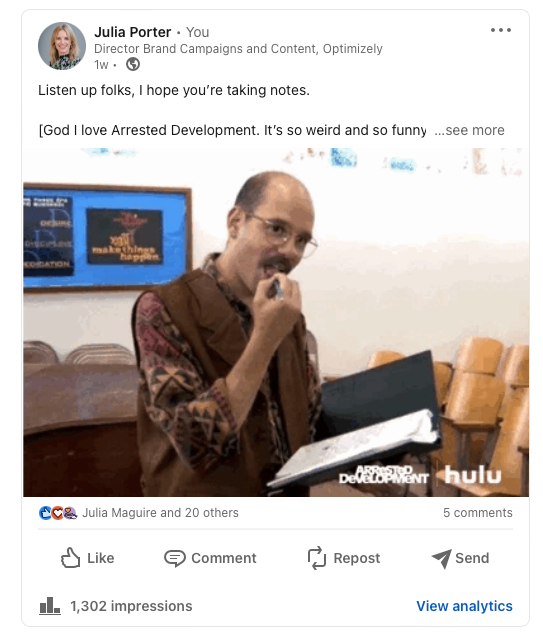
- Invited feedback: Over the course of a few weekswe invited collaborators to comment in a shared doc as a way of taking iterative feedback, getting ideas for the next scope of work, and also – bringing people on the journey of creating the guidelines. Look at all those reviewers! Doing this within our Content Marketing Platform (CMP) ensured that all that feedback was captured in one place, and that we could manage the process clearly, step by step:
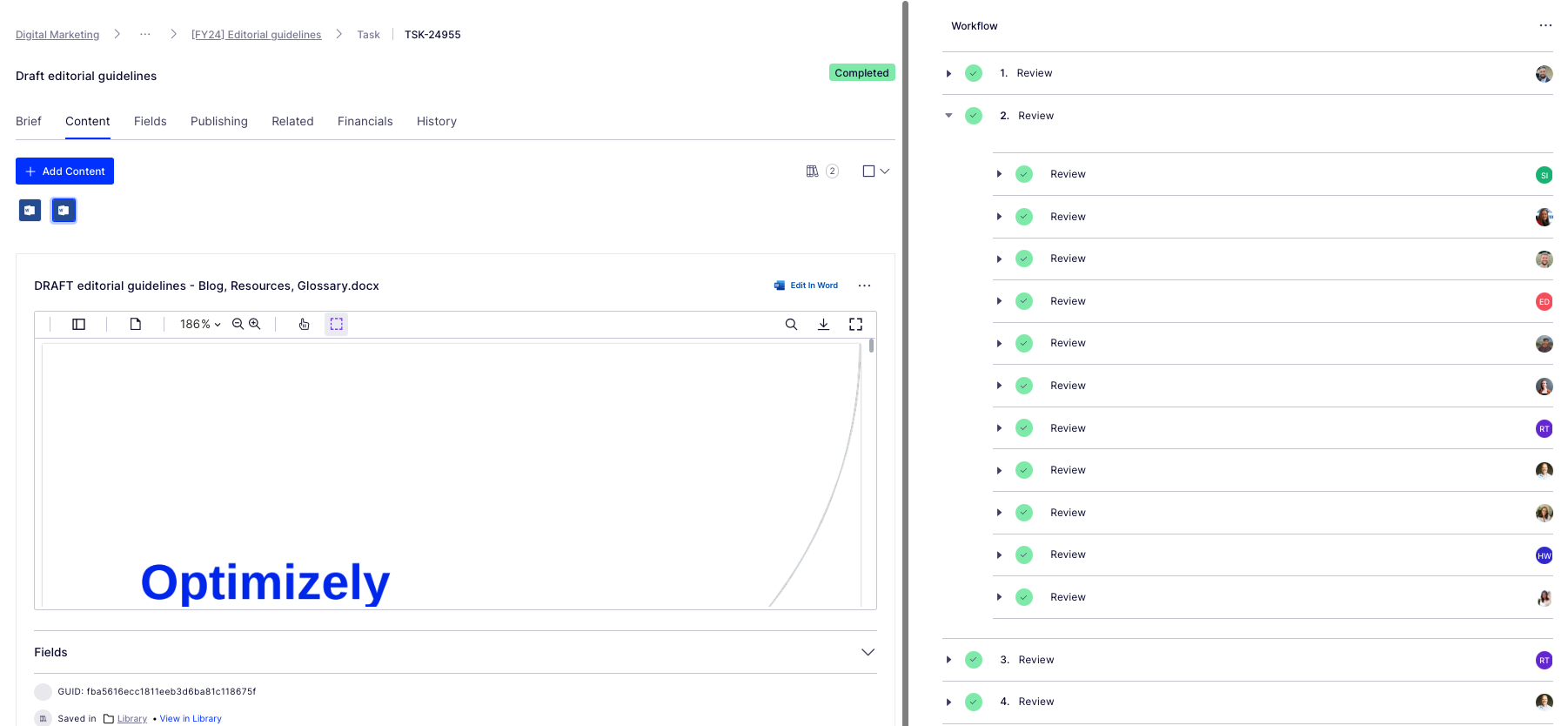
Look at all those collaborators! Thanks guys! And all of those beautiful ticks, so satisfying. So glad I could crop out the total outstanding tasks for this screen grab too (Source – Optimizely CMP)
- Updated content workflow: Now we have clear, documented guidance in place, we’ve included this as a step – the first step – in the workflow used for blog post creation:
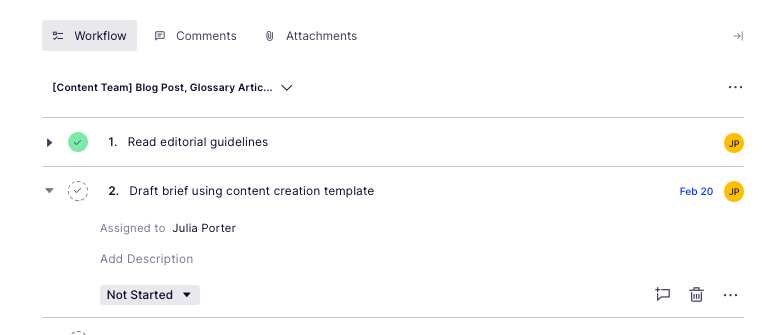
Source: Optimizely CMP
Results
It’s early days but we’re already seeing more engagement with the content creation process, especially amongst the teams involved in building the guidelines (which was part of the rationale in the first place :))

Source: My Teams chat
It’s inspired teams to think differently about the types of content we want to produce going forwards – for the blog and beyond.
I’d also say it’s boosted team morale and collaboration, helping different teams work together on shared goals to produce better quality work.
What’s next?
We’re busy planning wider communication of the editorial guidelines beyond marketing. We’ve kept the original draft and regularly share this with existing and potential collaborators for ongoing commentary, ideas and feedback.
Creating guidelines has also sparked discussion about the types of briefs and templates we want and need to create in CMP to support creating different assets. Finding the right balance between creative approach and using templates to scale content production is key.
We’ll review these guidelines on a quarterly basis and evolve as needed, adding new formats and channels as we go.
Key takeaways
- Editorial guidelines are a useful way to guide content creators as part of your overall content strategy
- Taking the time to do research upfront can help accelerate seemingly complex projects. Don’t be afraid to ask your community for inputs and advice as you create
- Keep the scope small at first rather than trying to align everything all at once. Test and learn as you go
- Work with stakeholders to build guidelines from the ground up to ensure you create a framework that is useful, relevant and used
And lastly, here’s that free template we created to help you build or evolve your own editorial guidelines!
MARKETING
Effective Communication in Business as a Crisis Management Strategy

Everyday business life is full of challenges. These include data breaches, product recalls, market downturns and public relations conflicts that can erupt at any moment. Such situations pose a significant threat to a company’s financial health, brand image, or even its further existence. However, only 49% of businesses in the US have a crisis communications plan. It is a big mistake, as such a strategy can build trust, minimize damage, and even strengthen the company after it survives the crisis. Let’s discover how communication can transform your crisis and weather the chaos.
The ruining impact of the crisis on business
A crisis can ruin a company. Naturally, it brings losses. But the actual consequences are far worse than lost profits. It is about people behind the business – they feel the weight of uncertainty and fear. Employees start worrying about their jobs, customers might lose faith in the brand they once trusted, and investors could start looking elsewhere. It can affect the brand image and everything you build from the branding, business logo, social media can be ruined. Even after the crisis recovery, the company’s reputation can suffer, and costly efforts might be needed to rebuild trust and regain momentum. So, any sign of a coming crisis should be immediately addressed. Communication is one of the crisis management strategies that can exacerbate the situation.
The power of effective communication
Even a short-term crisis may have irreversible consequences – a damaged reputation, high employee turnover, and loss of investors. Communication becomes a tool that can efficiently navigate many crisis-caused challenges:
- Improved trust. Crisis is a synonym for uncertainty. Leaders may communicate trust within the company when the situation gets out of control. Employees feel valued when they get clear responses. The same applies to the customers – they also appreciate transparency and are more likely to continue cooperation when they understand what’s happening. In these times, documenting these moments through event photographers can visually reinforce the company’s messages and enhance trust by showing real, transparent actions.
- Reputation protection. Crises immediately spiral into gossip and PR nightmares. However, effective communication allows you to proactively address concerns and disseminate true information through the right channels. It minimizes speculation and negative media coverage.
- Saved business relationships. A crisis can cause unbelievable damage to relationships with employees, customers, and investors. Transparent communication shows the company’s efforts to find solutions and keeps stakeholders informed and engaged, preventing misunderstandings and painful outcomes.
- Faster recovery. With the help of communication, the company is more likely to receive support and cooperation. This collaborative approach allows you to focus on solutions and resume normal operations as quickly as possible.
It is impossible to predict when a crisis will come. So, a crisis management strategy mitigates potential problems long before they arise.
Tips on crafting an effective crisis communication plan.
To effectively deal with unforeseen critical situations in business, you must have a clear-cut communication action plan. This involves things like messages, FAQs, media posts, and awareness of everyone in the company. This approach saves precious time when the crisis actually hits. It allows you to focus on solving the problem instead of intensifying uncertainty and panic. Here is a step-by-step guide.
Identify your crisis scenarios.
Being caught off guard is the worst thing. So, do not let it happen. Conduct a risk assessment to pinpoint potential crises specific to your business niche. Consider both internal and external factors that could disrupt normal operations or damage the online reputation of your company. Study industry-specific issues, past incidents, and current trends. How will you communicate in each situation? Knowing your risks helps you prepare targeted communication strategies in advance. Of course, it is impossible to create a perfectly polished strategy, but at least you will build a strong foundation for it.
Form a crisis response team.
The next step is assembling a core team. It will manage communication during a crisis and should include top executives like the CEO, CFO, and CMO, and representatives from key departments like public relations and marketing. Select a confident spokesperson who will be the face of your company during the crisis. Define roles and responsibilities for each team member and establish communication channels they will work with, such as email, telephone, and live chat. Remember, everyone in your crisis response team must be media-savvy and know how to deliver difficult messages to the stakeholders.
Prepare communication templates.
When a crisis hits, things happen fast. That means communication needs to be quick, too. That’s why it is wise to have ready-to-go messages prepared for different types of crises your company may face. These messages can be adjusted to a particular situation when needed and shared on the company’s social media, website, and other platforms right away. These templates should include frequently asked questions and outline the company’s general responses. Make sure to approve these messages with your legal team for accuracy and compliance.
Establish communication protocols.
A crisis is always chaotic, so clear communication protocols are a must-have. Define trigger points – specific events that would launch the crisis communication plan. Establish a clear hierarchy for messages to avoid conflicting information. Determine the most suitable forms and channels, like press releases or social media, to reach different audiences. Here is an example of how you can structure a communication protocol:
- Immediate alert. A company crisis response team is notified about a problem.
- Internal briefing. The crisis team discusses the situation and decides on the next steps.
- External communication. A spokesperson reaches the media, customers, and suppliers.
- Social media updates. A trained social media team outlines the situation to the company audience and monitors these channels for misinformation or negative comments.
- Stakeholder notification. The crisis team reaches out to customers and partners to inform them of the incident and its risks. They also provide details on the company’s response efforts and measures.
- Ongoing updates. Regular updates guarantee transparency and trust and let stakeholders see the crisis development and its recovery.
Practice and improve.
Do not wait for the real crisis to test your plan. Conduct regular crisis communication drills to allow your team to use theoretical protocols in practice. Simulate different crisis scenarios and see how your people respond to these. It will immediately demonstrate the strong and weak points of your strategy. Remember, your crisis communication plan is not a static document. New technologies and evolving media platforms necessitate regular adjustments. So, you must continuously review and update it to reflect changes in your business and industry.
Wrapping up
The ability to handle communication well during tough times gives companies a chance to really connect with the people who matter most—stakeholders. And that connection is a foundation for long-term success. Trust is key, and it grows when companies speak honestly, openly, and clearly. When customers and investors trust the company, they are more likely to stay with it and even support it. So, when a crisis hits, smart communication not only helps overcome it but also allows you to do it with minimal losses to your reputation and profits.
MARKETING
Should Your Brand Shout Its AI and Marketing Plan to the World?

To use AI or not to use AI, that is the question.
Let’s hope things work out better for you than they did for Shakespeare’s mad Danish prince with daddy issues.
But let’s add a twist to that existential question.
CMI’s chief strategy officer, Robert Rose, shares what marketers should really contemplate. Watch the video or read on to discover what he says:
Should you not use AI and be proud of not using it? Dove Beauty did that last week.
Should you use it but keep it a secret? Sports Illustrated did that last year.
Should you use AI and be vocal about using it? Agency giant Brandtech Group picked up the all-in vibe.
Should you not use it but tell everybody you are? The new term “AI washing” is hitting everywhere.
What’s the best option? Let’s explore.
Dove tells all it won’t use AI
Last week, Dove, the beauty brand celebrating 20 years of its Campaign for Real Beauty, pledged it would NEVER use AI in visual communication to portray real people.
In the announcement, they said they will create “Real Beauty Prompt Guidelines” that people can use to create images representing all types of physical beauty through popular generative AI programs. The prompt they picked for the launch video? “The most beautiful woman in the world, according to Dove.”
I applaud them for the powerful ad. But I’m perplexed by Dove issuing a statement saying it won’t use AI for images of real beauty and then sharing a branded prompt for doing exactly that. Isn’t it like me saying, “Don’t think of a parrot eating pizza. Don’t think about a parrot eating pizza,” and you can’t help but think about a parrot eating pizza right now?
Brandtech Group says it’s all in on AI
Now, Brandtech Group, a conglomerate ad agency, is going the other way. It’s going all-in on AI and telling everybody.
This week, Ad Age featured a press release — oops, I mean an article (subscription required) — with the details of how Brandtech is leaning into the takeaway from OpenAI’s Sam Altman, who says 95% of marketing work today can be done by AI.
A Brandtech representative talked about how they pitch big brands with two people instead of 20. They boast about how proud they are that its lean 7,000 staffers compete with 100,000-person teams. (To be clear, showing up to a pitch with 20 people has never been a good thing, but I digress.)
OK, that’s a differentiated approach. They’re all in. Ad Age certainly seemed to like it enough to promote it. Oops, I mean report about it.
False claims of using AI and not using AI
Offshoots of the all-in and never-will approaches also exist.
The term “AI washing” is de rigueur to describe companies claiming to use AI for something that really isn’t AI. The US Securities and Exchange Commission just fined two companies for using misleading statements about their use of AI in their business model. I know one startup technology organization faced so much pressure from their board and investors to “do something with AI” that they put a simple chatbot on their website — a glorified search engine — while they figured out what they wanted to do.
Lastly and perhaps most interestingly, companies have and will use AI for much of what they create but remain quiet about it or desire to keep it a secret. A recent notable example is the deepfake ad of a woman in a car professing the need for people to use a particular body wipe to get rid of body odor. It was purported to be real, but sharp-eyed viewers suspected the fake and called out the company, which then admitted it. Or was that the brand’s intent all along — the AI-use outrage would bring more attention?
This is an AI generated influencer video.
Looks 100% real. Even the interior car detailing.
UGC content for your brand is about to get really cheap. ☠️ pic.twitter.com/2m10RqoOW3
— Jon Elder | Amazon Growth | Private Label (@BlackLabelAdvsr) March 26, 2024
To yell or not to yell about your brand’s AI decision
Should a brand yell from a mountaintop that they use AI to differentiate themselves a la Brandtech? Or should a brand yell they’re never going to use AI to differentiate themselves a la Dove? Or should a brand use it and not yell anything? (I think it’s clear that a brand should not use AI and lie and say it is. That’s the worst of all choices.)
I lean far into not-yelling-from-mountaintop camp.
When I see a CEO proudly exclaim that they laid off 90% of their support workforce because of AI, I’m not surprised a little later when the value of their service is reduced, and the business is failing.
I’m not surprised when I hear “AI made us do it” to rationalize the latest big tech company latest rounds of layoffs. Or when a big consulting firm announces it’s going all-in on using AI to replace its creative and strategic resources.
I see all those things as desperate attempts for short-term attention or a distraction from the real challenge. They may get responses like, “Of course, you had to lay all those people off; AI is so disruptive,” or “Amazing. You’re so out in front of the rest of the pack by leveraging AI to create efficiency, let me cover your story.” Perhaps they get this response, “Your company deserves a bump in stock price because you’re already using this fancy new technology.”
But what happens if the AI doesn’t deliver as promoted? What happens the next time you need to lay off people? What happens the next time you need to prove your technologically forward-leaning?
Yelling out that you’re all in on a disruptive innovation, especially one the public doesn’t yet trust a lot is (at best) a business sugar high. That short-term burst of attention may or may not foul your long-term brand value.
Interestingly, the same scenarios can manifest when your brand proclaims loudly it is all out of AI, as Dove did. The sugar high may not last and now Dove has itself into a messaging box. One slip could cause distrust among its customers. And what if AI gets good at demonstrating diversity in beauty?
I tried Dove’s instructions and prompted ChatGPT for a picture of “the most beautiful woman in the world according to the Dove Real Beauty ad.”
It gave me this. Then this. And this. And finally, this.
She’s absolutely beautiful, but she doesn’t capture the many facets of diversity Dove has demonstrated in its Real Beauty campaigns. To be clear, Dove doesn’t have any control over generating the image. Maybe the prompt worked well for Dove, but it didn’t for me. Neither Dove nor you can know how the AI tool will behave.
To use AI or not to use AI?
When brands grab a microphone to answer that question, they work from an existential fear about the disruption’s meaning. They do not exhibit the confidence in their actions to deal with it.
Let’s return to Hamlet’s soliloquy:
Thus conscience doth make cowards of us all;
And thus the native hue of resolution
Is sicklied o’er with the pale cast of thought,
And enterprises of great pith and moment
With this regard their currents turn awry
And lose the name of action.
In other words, Hamlet says everybody is afraid to take real action because they fear the unknown outcome. You could act to mitigate or solve some challenges, but you don’t because you don’t trust yourself.
If I’m a brand marketer for any business (and I am), I’m going to take action on AI for my business. But until I see how I’m going to generate value with AI, I’m going to be circumspect about yelling or proselytizing how my business’ future is better.
HANDPICKED RELATED CONTENT:
Cover image by Joseph Kalinowski/Content Marketing Institute
-

 PPC7 days ago
PPC7 days ago19 Best SEO Tools in 2024 (For Every Use Case)
-
SEARCHENGINES6 days ago
Daily Search Forum Recap: April 19, 2024
-
SEARCHENGINES7 days ago
Daily Search Forum Recap: April 18, 2024
-

 WORDPRESS6 days ago
WORDPRESS6 days agoHow to Make $5000 of Passive Income Every Month in WordPress
-

 SEO7 days ago
SEO7 days ago25 WordPress Alternatives Best For SEO
-

 WORDPRESS6 days ago
WORDPRESS6 days ago7 Best WooCommerce Points and Rewards Plugins (Free & Paid)
-

 WORDPRESS5 days ago
WORDPRESS5 days ago13 Best HubSpot Alternatives for 2024 (Free + Paid)
-

 MARKETING6 days ago
MARKETING6 days agoBattling for Attention in the 2024 Election Year Media Frenzy


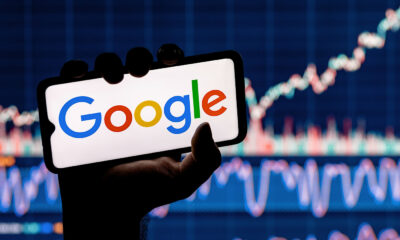

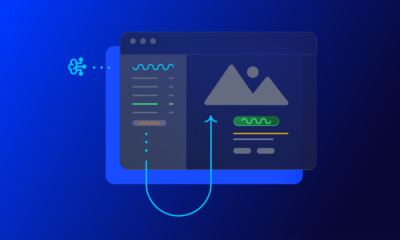









You must be logged in to post a comment Login